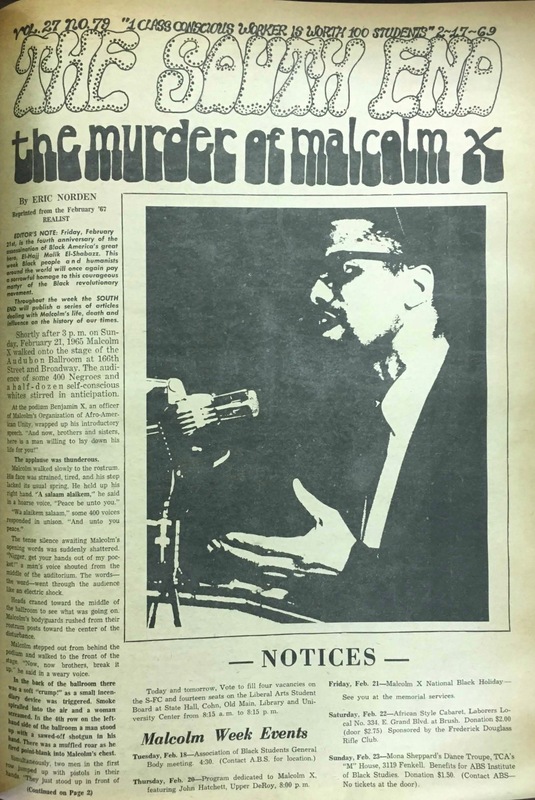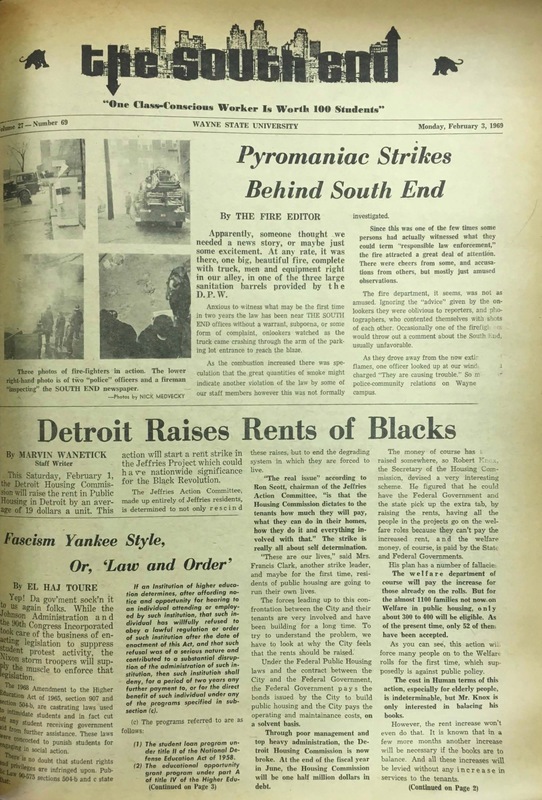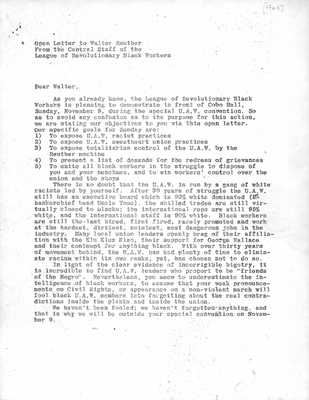League of Revolutionary Black Workers Teacher Plan
General Background: On May 2, 1968, 4,000 workers at the Chrysler Dodge Main plant in Hamtramck, Michigan staged a wildcat strike to protest working conditions and the racist practices of manufacturers, who they claimed deliberately assigned blacks and other minorities to work the most dangerous jobs in the factory, and prevented them the opportunity to acquire better-paying positions.
What emerged from the Dodge Main strike was the creation of the Dodge Revolutionary Union Movement (DRUM) founded by General Gordon Baker, Mike Hamlin, John Watson, Ron March and others, all of whom had previously been active in various radical and civil rights organizations. Following DRUM, black workers formed similar groups at other automobile plants, including FRUM at Ford, ELRUM at the Eldon Avenue Chrysler plant and JARUM at the Jefferson Avenue plant. In 1969, the League of Revolutionary Black Workers (LRBW) was formed as the central organization under which the various RUM groups would be united.
In addition to their criticisms of manufacturers, members of the League charged leaders of the United Auto Workers (UAW) – one of the most influential labor unions in the twentieth century – with being unresponsive to the concerns of black workers and obstinate in allowing blacks into the union’s leadership structure. Furthermore, League members condemned the UAW for its capitulation to corporate interests after World War II – that is, prioritizing profits over workers’ power and conditions.
To make their demands heard, League members used several tactics, including wildcat strikes and publishing plant newsletters detailing specific grievances. During the 1968-69 academic year, Watson and Hamlin became editors of The South End, Wayne State University’s student newspaper.
In 1971, the League of Revolutionary Black Workers disbanded, due largely to a combination of factional infighting and FBI repression.
For teachers: This set of documents and exercises is designed for 9-12 grade students. These sets can be used to fulfill Common Core Standards CCSS.ELA-Literacy RH.11-12(1-10) and RH.9.10(1-10).
A History or Social Studies course should plan to spend 2-3 class sessions working through this unit, though teachers may find it appropriate to mix and match the material provided depending on existing curriculum and readings.
Students will develop critical thinking skills, compare various perspectives, and practice interrogating primary sources related to the social and political life of 1960s.
Lesson #1 – Create an issue-driven Newspaper (50 minutes)
Background: During the 1968-69 school year, John Watson and Mike Hamlin became editors of Wayne State University’s student newspaper, The South End. Both were heavily involved in the Dodge Revolutionary Union Movement and sought to use their new editorial power to shift the paper’s focus from a university-centered publication to one that represented exploited working class people more broadly. Watson’s first editorial appeared in September 1968 and stated, “The South End returns to Wayne State with the intention of promoting the interests of impoverished, oppressed, exploited, and powerless victims of white, racist monopoly capitalism and imperialism.”
With the shift in tone and direction of the paper, The South End staff faced immense institutional pushback, specifically from then Wayne State President William Keast. As a result, the staff made some concessions to appease Keast, such as vowing not print obscene language, to avoid being shut down by the university. However, Watson, Hamlin and Nick Medvecky, who was in charge of printing the daily paper, made it clear that the politics of The South End would not change.
Objective: Through an analysis of an issue of The South End from the 1968-69 school year, students will gain a better understanding of the various topics covered by the paper, and get a glimpse of what was happening in the world during this time from the perspectives of the paper’s editors and staff writers. Students should keep in mind the role media plays in helping a movement gain momentum.
Instructions: Start by examining an issue of The South End during the time Hamlin and Watson were editors. Ask students to consider the following questions: What kind of articles do you see? Do you notice anything about the design? Who do you think is the intended audience? When was the issue published? Why do you think it was important for them to have the paper as a resource? How can this method of communicating be effective?
After the discussion, put students in groups of 3-4 and have them create their own newspaper featuring articles about contemporary issues they are passionate about. Have them choose one editor (if this becomes a point of contention, the instructor should choose), followed by three staff writers. Everyone in the group should confer to determine the design of the paper, its editorial stance and what kind of issues are going to be covered, as well as the intended audience. For the sake of time, have students create headlines to indicate what issues will be covered. Upon completion, have each editor present their papers to the rest of the class.
Potential Homework Assignment: Read Detroit: I Do Mind Dying by Dan Georgakas and Marvin Surkin, Chapter 3, We Will Take the Hard Line
Lesson #2 – The League vs. The UAW (25-30 minutes)
Objective: To help students understand why members of the League of Revolutionary Black Workers opposed the leadership of the United Automobile Workers Union (UAW) through analysis of a letter sent by the Central Staff of the League to UAW President Walter Reuther. From there, students will be able to draw some conclusions about the nature of the relationship between the two organizations, but should also be left to question if those conclusions are sound given the absence of the UAW’s perspective.
Instructions: Distribute copies of the “Open Letter to Walter Reuther” to students and have them first read it carefully to themselves. Pose the following questions for them to answer while reading:
- Who is the letter to? Who is it from?
- When was the letter written?
- How did the League view Reuther and the UAW? What specific problems did the letter address? (underline them)
- Why is the letter significant as it relates to why the LRBW was formed?
After discussing these questions, ask students to consider whether the letter is sufficient enough evidence to be able to sufficiently characterize the relationship between the League and the UAW. In other words: What interpretive problems arise when there is not enough evidence to draw firm conclusions? How does that affect the way we study and learn about history?
Potential HW assignment:
- Read Detroit: I Do Mind Dying, Chapter Five, Niggermation at Eldon
- Read From Motor City to Motor Metropolis: How the Automobile Industry Reshaped Urban America by Thomas Sugrue (http://www.autolife.umd.umich.edu/Race/R_Overview/R_Overview.htm)
- Read, The American Revolution: Pages from a Negro Workers Notebook by James Boggs, Chapter 1, The Rise and Fall of the Union
Lesson #3 – Finally Got The News (40-45 minutes)
Objective: Through interviews with members of the LRBW, footage from the auto plants and of demonstrations and actions, students will gain an understanding of the specific ways in which members of the League worked to build an independent political organization that would fight for better working conditions for black and white workers. The film will also better understand the particular historical context in which the League formed and the ideological tendencies of members of the LRBW.
Instructions: Set aside an entire class period to screen a significant portion of the 1970 documentary film Finally Got the News (preferably from the 5:00 mark to 25:30). While viewing the film, ask students to consider the following questions:
- What do you think is the purpose of the film?
- Who do you think produced the film? Was it documented externally or by people within the League? Who was interviewed?
- When was the documentary filmed?
- How can a visual primary source like Finally Got the News help us understand what the conditions were like for workers in automobile plants at the time?
- Why is the film significant? What does it tell you about how social movements are formed?
Potential HW assignment:
- Read, Detroit: I Do Mind Dying, Chapter 6, Finally Got the News
- Listen to Dan Georgakas, coauthor of Detroit: I Do Mind Dying, and Herb Boyd, author and former Wayne State Professor, discuss the history of the League on the Working Class History podcast


